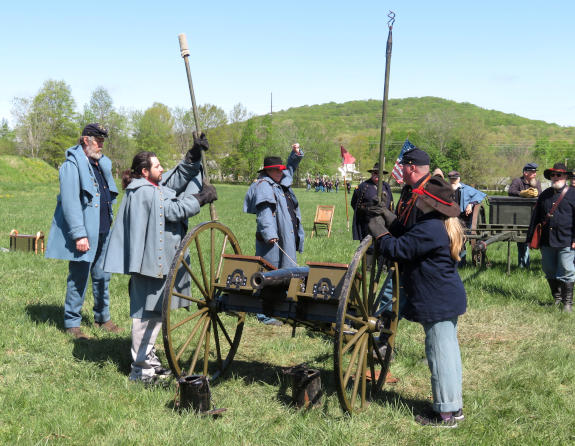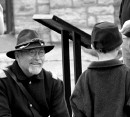NEWS OF 150 YEARS AGO
July/August 1861
From The Missouri Democrat, Friday, July 12, 1861.
SIGEL’S RETREAT.
Splendid Military Movements.
HOW TO RETREAT BEFORE A SUPERIOR FORCE AND STILL WHIP THEM.
It is conceded by all military men that the retreat of Col. Sigel’s command before the superior rebel forces under Gen. Rains and Parsons, in the neighborhood of Carthage, Mo., on the 5th of July, was one of the most masterly military maneuvres the war has yet exhibited. Indeed, it is claimed by many officers of large experience that a more admirable display of military science has never been witnessed in this country. It at once places Col. Sigel in the front ranks of the military men of the day and fully justifies the reputation which he brought with him to this country from the old world. Gen. Lyon undoubtedly knew his man when he entrusted Col. Sigel with the important command of the advance by the way of Rolla and Springfield into the Southwest of the State. He knew that upon the rout of the rebels in the interior of the State, their only outlet and way of escape was through the Southwest, and, duly appreciating the eminent qualifications of Colonel Sigel, he at once entrusted him with the command of a body of troops whose business it should be to harass, and if possible cut off the fugitives in the neighborhood of Springfield and Carthage. Col. Sigel, it seems, promptly reached his destination, gave courage and organization to the Home Guards of the southwest sections of the State, and as the sequel has proved, gave the rebels a taste of the spirit and skill of the German soldiery, from which they never will recover, and which they will be lo[a]th to test in any manner again. All honor to Col. Sigel and the brave German officers and soldiers under him. He has proved himself a nobel General, and his command a band of heroes.
We may estimate the value of the services rendered by him and them to the country, and we may place something like a fair estimate upon his military skill if with recent examples in Virginia before our eyes, we but reflect a moment upon the probably results of the Carthage fight, if the United States forces had been under the command of any of our inexperienced military officers. Where is the volunteer officer in the whole country, who, in the face of such tremendous odds, could have managed a whole day’s retreat as admirably, preserving his baggage teams, killing so many of the enemy, and suffering so small a loss himself?
It is one thing to sound the charge and push on to victory an enthusiastic and well-appointed body of men. It is quite another foe with perfect order and the preservation of men and their cumbersome artillery and baggage. Happily for our German soldiery, and thrice fortunate for the cause of the government, was it that Gen. Lyon was so clear in his estimate of the man for the place—Col. Sigel for the Southwest.
In yesterday’s paper we gave a narrative of the fight, as detailed to us by Lieutenant Tusk. To-day, by his assistance we present a few diagrams, which will help the reader to form a correct idea of the nature of the difficulties under which Col. Sigel labored, and the quality of the generalship which finally extricated his command from the fearful dangers which beset them.
Here is diagram No. 1, which represents the respective positions of the contending forces when the battle begun. The stars represent the cavalry, dots for the infantry, daggers the artillery, and parallels the wagons.

The forces of the rebels under Gen. Rains and Parsons, were estimated at 5,000, including 1,500 cavalry. They occupied a high ridge in the prairie about seven miles from Carthage, their cavalry extending along the rear and on the flank, their artillery of one twenty-four pounder in the centre, supported by two six-pounders on each side, as represented. The position was a well-chosen and strong one.
Col. Sigel displayed his force of about 1,100 men, to the very best advantage, four pieces of artillery in the centre, and two pieces at the extreme of each flank, the infantry stationed in columns on the right and left, and in the rear. In this condition the fight began, and continued for about three hours, when the rebels’ artillery, having been dismounted, and their centre broken, they commenced flank movements with their cavalry, threatening an attack in the rear, and the capture of Col. Sigel’s baggage train three miles behind. The Colonel sent back one piece of artillery and a detachment of infantry to guard a ferry, and then commenced a retrograde movement with his entire command, at the same time dispatching an order for the advance for the advance of the baggage wagons. In this movement he preserved the order of his columns until the baggage train was reached, when he immediately made the following admirable disposition of his forces, as seen by diagram No. 2:

In the order as presented in the above, Colonel Salomon’s battalion leading the front, the retreat was continued from about midday until 5 o’clock P. M., the enemy threatening on all sides, but being constantly repulsed by the well handled artillery and serried front of the infantry. The baggage wagons numbered about fifty, and were moved in columns of eight.
At 5 o’clock Sigel’s force came to a small creek, just beyond which was a bluff, intersected by the road to Carthage, along which he was moving. On the two sides of this divided bluff 800 of the rebel of cavalry took position, prepared to resist the passage of the creek and road. The position was one of difficulty, and would have seriously perplexed any less skillful officer than Colonel Sigel. His head was cool, however, and to gain the advantage, he resorted to a splendid stratagem which placed his foes entirely at his mercy, and eventually secured the unimpeded movements of his command. He ordered an oblique movement on the right and left of his forces, as if to pass around the sides of the bluff, at the same time advancing the two pieces of artillery on the sides, to a position in front, giving Col. Salomon’s battalion the strength of two pieces on his right and two on his left. The oblique movements of the infantry were accompanied by a feint of the artillery in the same direction. The rebel cavalry of course construing these manœuvres very much in their favor, rushed down into the road from both sidesof the bluff, intending, no doubt, to make a grand charge upon Col. Sigel’s center. With the quickness of thought, the movements to the right and left were reversed and a terribly destructive cross-fire was opened upn the rebels, the distance being but about 300 yards, and the guns charged heavily with grape-shot. In ten minutes the route [sic] of the cavalry was complete. Diagram No. 3, will assist the reader in his appreciation of the brilliancy of this movement.

Another manœuvre was of very great assistance to Col. Sigel, later in the evening when he was trying to gain the woods near Carthage. By commanding his men to hoist their muskets high over their heads whil marching behind a high bank, the rebels were deceived as to the direction they were taking and were drawn into a kind of ambuscade, where they suffered very severely.
Gaining the woods near Carthage and darkness coming on, the rebels retreated, and Col. Sigel, notwithstanding the great fatigue of his men, took up his line of march for Sarcoxie, a distance of twelve or fourteen miles, which he reached in due season, and took refreshments, and a good rest for his men.
We challenge anything in the history of wars of this country that will surpass this masterly retreat of Col. Sigel and his brave German troops.



